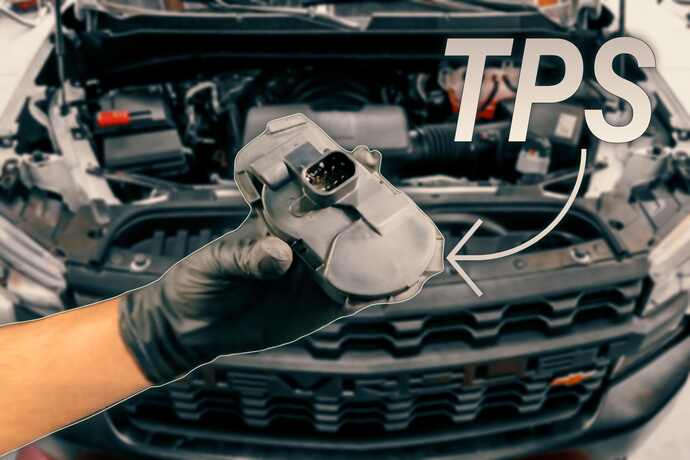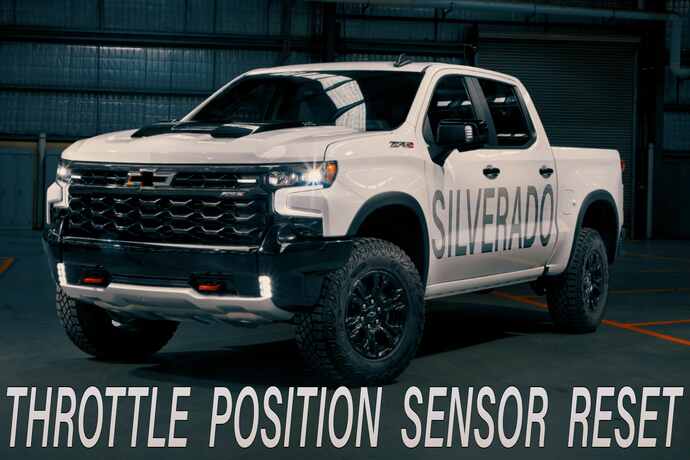The Chevrolet Silverado is a reliable and popular truck among users.
Transfer case problems are a common and significant issue that Silverado owners need to be aware of.
It transfers power between the front and rear wheels, making it a vital part of the drivetrain system.
However, the transfer case, like any mechanical system, can experience issues that reduce its engine performance and reliability.
If Silverado owners can confidently identify and resolve these issues, it will ensure optimal vehicle performance.
Let’s discuss common Chevy Silverado transfer case problems and how to reset the TCM.
What is the Throttle Position Sensor?

The throttle position sensor is crucial for the Silverado’s engine performance.
It is responsible for monitoring the position of the throttle valve in the engine’s intake manifold.
TCM controls the air entering the engine, directly affecting the engine’s power output.
The sensor detects the throttle valve’s position and sends the information to the engine control module.
ECM adjusts engine parameters like fuel delivery and ignition timing based on the throttle position sensor’s signal.
TCM helps the ECM optimize the engine’s performance and efficiency by precisely measuring the throttle position.
The sensor also informs the engine exactly how much the throttle valve is open, which is vital information for the ECM to determine the appropriate amount of fuel to inject into the engine and the precise timing for ignition.
The throttle position sensor maintains power and fuel efficiency balance to ensure a smooth and responsive driving experience.
It continuously monitors the throttle position and ensures the engine operates smoothly and efficiently under different driving conditions.
Symptoms of a Bad Throttle Position Sensor

A bad throttle position sensor in a Silverado shows some basic symptoms. It will be much easier to diagnose and treat the problems if you know what to look for. The symptoms of a bad throttle position sensor include unstable engine idle, stalling or hesitation, acceleration issues, low fuel economy, check engine light, etc. If you’re experiencing any of the following issues in your Silverado, it could be due to a bad throttle position sensor:
Unstable engine idle: The engine may idle too high or too low, resulting in a rough or fluctuating idle.
Stalling or hesitation: You may experience stalling or hesitation when trying to accelerate or maintain a constant speed.
Acceleration issues: You might feel like you don’t have enough power or have trouble accelerating easily.
Low fuel economy: A faulty throttle position sensor can affect the air-fuel mixture, decreasing fuel efficiency. You may notice that your Silverado is consuming more fuel than usual.
Check Engine Light: Sometimes, a bad throttle position sensor can trigger the Check Engine Light on your Silverado’s dashboard. It is suggested that the vehicle’s on-board diagnostic system be checked for error codes in order to validate the problem.
You can also follow the video for better understanding:
If you suspect that your Silverado is experiencing issues with its throttle position sensor, it is best to seek the assistance of a professional mechanic. The symptoms of this problem can differ depending on the specific model and year of your vehicle, so it’s always better to let an expert diagnose and repair the issue.
How to Reset Throttle Position Sensor Chevy Silverado
Resetting the throttle position sensor may solve most of your Silverado’s throttle position sensor-related issues. A user needs to know how to reset the sensor. To reset the throttle position sensor in your truck, you can follow these steps:
- First, turn off the engine and remove the key from the ignition.
- The next step is to locate the throttle body, which is usually found on the intake manifold.
- After that, disconnect the electrical connector from the throttle position sensor. You can do this by pressing a tab or releasing a locking mechanism.
- Wait for about 30 seconds to let any remaining power dissipate.
- Reconnect the electrical connector to the throttle position sensor.
- Start the engine and let it idle for a few minutes to allow the throttle position sensor to recalibrate.
- Finally, take your Silverado for a test drive to ensure that the throttle response is smooth and there are no issues with acceleration or idle.
You may face other problems while resetting the throttle position sensor. Furthermore, you may need help to solve the issues. I suggest you seek help from a professional mechanic if necessary.
Precautions Resetting Throttle Position Sensor

Safely resetting the throttle position sensor in your Silverado requires that you observe all applicable safety procedures. Please consider the following safety measures:
Safety first: Be sure to take the key out of the ignition and turn off the engine before beginning any maintenance on your vehicle. It will lessen the likelihood of any unexpected ignitions or electrical shocks.
Disconnecting the battery: Disconnecting the battery’s negative connection is a good idea before servicing the throttle position sensor. Doing so will prevent any power surges or damage to the sensor.
Following the proper procedure: When disconnecting and reconnecting the electrical connector to the throttle position sensor, follow the user manual as instructed. This may involve pressing a tab or releasing a locking mechanism. Improper handling can lead to damage or wrong connection.
Power dissipation: It’s advisable to allow about 30 seconds for any residual power to dissipate after disconnecting the electrical connector. This will ensure a clean reset of the throttle position sensor.
Rechecking connections: Double-check that all connections are securely reconnected before starting the engine. Loose or improper links can lead to malfunctioning of the throttle position sensor.
Test driving: After resetting the throttle position sensor, take your Silverado for a test drive to ensure that the throttle response is smooth and there are no issues with acceleration or idle. Pay attention to any abnormal behavior and address it promptly if necessary.
Following these precautions, you can easily avoid potential harm to yourself and your vehicle.
How to Prevent Throttle Position Sensor Issues

You can take the following preventive measures to prevent issues with the throttle position sensor in your Silverado:
Regular maintenance: Follow your Silverado’s recommended maintenance schedule, including regular inspections and servicing of the throttle position sensor and related components.
Cleaning throttle body: Carbon deposits can accumulate on the throttle body, affecting the sensor’s performance over time. Use a throttle body cleaner on a regular basis to keep the throttle body free of buildup.
Using quality fuel: High-quality fuel can help prevent the accumulation of deposits in the fuel system, including the throttle body and sensor. You should use fuels from reputed and trusted sources.
Avoiding reckless driving: Excessive acceleration and abrupt throttle movements can strain the throttle position sensor more. Practice smooth and gradual acceleration to reduce wear and tear on the sensor.
Vacuum leaks checking: Vacuum leaks can affect the proper functioning of the throttle position sensor. Keep an eye out for leaks in the vacuum system and have any faulty components fixed immediately.
Protecting electrical connections: Ensure that the electrical connections to the throttle position sensor are secure and protected from moisture, dirt, and corrosion. Inspect the connections periodically and clean or repair them as necessary.
Warning signs: Rough idling, sluggish acceleration, and engine misfires are all signs that your vehicle’s throttle position sensor may be failing. Have your vehicle checked out as soon as possible by a professional mechanic.
Following these preventive measures can reduce the likelihood of throttle position sensor issues in your Silverado. It is important to remember that these precautions do not ensure total prevention. Regular maintenance and attentive driving habits are crucial to keeping your vehicle in optimal condition.
FAQs
Can you drive without a throttle position sensor?
Don’t drive without a working throttle position sensor. It can cause engine issues, reduced fuel efficiency, safety risks, and emission problems. Address TPS issues promptly to avoid driving the vehicle with problems.
What are the different types of throttle position sensors?
Throttle position sensors come in two types: potentiometer-based and Hall effect-based. Potentiometer-based TPS uses a variable resistor to measure throttle position. At the same time, Hall effect-based TPS uses a Hall effect sensor to detect changes in a magnetic field caused by throttle movement.
Can a TPS cause shifting problems?
Yes, a malfunctioning throttle position sensor can cause harsh, delayed, or erratic shifting behavior in a vehicle. The TPS sends signals to the engine control unit to determine the proper shifting patterns. Since proper operation of the TPS is essential for reliable shifting, checking its condition is a must.
Where is the TPS located in a Silverado?
The throttle position sensor in a Silverado is normally situated on the throttle body. It is usually mounted on the side or top of the throttle body assembly, although its exact location may vary depending on the specific model and year of the Silverado.
Can a bad TPS cause reduced engine power?
Yes, a faulty throttle position sensor can reduce engine power. The TPS monitors the throttle plate position and signals the ECU to adjust fuel injection and ignition timing. Incorrect signals from a faulty TPS lead to improper fuel and air mixture, timing adjustments, and reduced throttle response.
Conclusion
The throttle position sensor is an essential component in a Silverado that helps monitor and control the throttle valve’s position.
It gives the engine control unit feedback about the throttle’s position, allowing the ECU to adjust the fuel and air mixture for optimal engine performance.
Faulty TPS can lead to various issues, including poor throttle response, shifting problems, reduced engine power, and even engine stalling.
If you think the TPS in your Silverado is malfunctioning, check the manual for symptoms and possible fixes.
Resetting the TPS may solve the issue; otherwise, contact a professional mechanic for assistance.
Proper maintenance and timely solving of issues can help ensure your Silverado is running smoothly and has the best performance.

